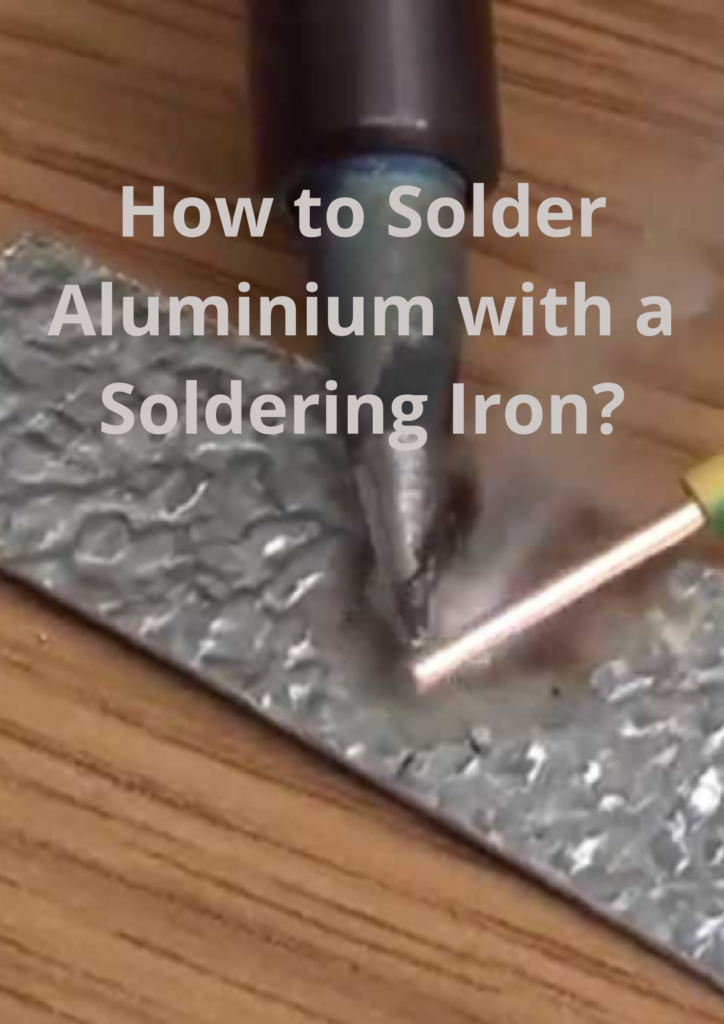
Soldering is a process of joining two metal surfaces together using a filler metal called solder. The soldering process involves heating the surfaces to be joined and melting the solder, which is then allowed to cool and solidify, creating a strong and durable joint.
In this article, we will look into the question “How to Solder Aluminium with a Soldering Iron?
To answer the question “How to Solder Aluminium with a Soldering Iron? You can follow these three general steps:
1. Preparation: Clean the aluminum surface with a stainless steel brush and clamp the pieces together.
2. Flux Application: Apply a specialized flux for aluminum to prevent oxide formation and draw the solder along the join.
3. Soldering: Heat the aluminum until the flux bubbles and turns light brown, then drag the solder across the places where you want the aluminum pieces to be joined together.
It’s important to know how to Solder Aluminium with a Soldering Iron? Aluminum requires a specialized solder with a lower melting point due to its low melting temperature of 1220ºF (660ºC). Additionally, some sources suggest using mineral oil to scrape away the oxide layer on the aluminum’s surface before soldering.
While some sources recommend using a torch for certain aluminum soldering jobs, it’s possible to solder aluminum using a soldering iron for specific applications.
- What type of solder is recommended when soldering Aluminium?
- what are some common mistakes to avoid on How to Solder Aluminium with a Soldering Iron?
- what are some tips for cleaning aluminium in the question How to Solder Aluminium with a Soldering Iron?
- what are some tools needed for cleaning aluminum before soldering?
- what is the best way to remove oxidation from aluminum before soldering?
- Are there any safety precautions or considerations specific to soldering aluminum?
- what type of gloves are recommended for soldering aluminum with a soldering iron?
- Helpful Resources
What type of solder is recommended when soldering Aluminium?
When soldering aluminum in the question How to Solder Aluminium with a Soldering Iron? It’s important to use a specialized solder with a lower melting point than general-purpose solders, as aluminum melts at a relatively low temperature of 1220ºF (660ºC).
Zinc-tin solder is a preferred option, and it’s important to avoid lead in any case. Certain filler alloy combinations, such as tin-zinc, tin-silver, SN100C, and ALUSAC-35, are better at creating an intermetallic bond with aluminum.
The recommended flux for aluminum soldering should contain Zinc Chloride, which is the specific activator that effectively etches the aluminum and allows the formation of the intermetallics needed for a strong solder joint.
The flux should be specialized for aluminum or for the combination of metals you plan to join.
what are some common mistakes to avoid on How to Solder Aluminium with a Soldering Iron?
When soldering aluminum, it’s important to avoid common mistakes to ensure a successful outcome. Here are some common mistakes to avoid when soldering aluminum:
1. Inadequate cleanliness: The primary problem in soldering aluminum is cleanliness. Oxidation and cross-contamination must be prevented. Ensure that the aluminum surface is clean and free from grease, oil, or any dirt before starting the soldering process.
2. Using the wrong flux: Using the wrong flux can prevent the solder from sticking to the metal surface. It’s important to use a specialized flux for aluminum to prevent further oxide formation and draw the solder along the join.
3. Insufficient heat: Aluminum is an excellent heat conductor, and it requires a fair bit of heat for successful soldering. Ensure that the soldering iron or torch is hot enough to melt the solder and tin the aluminum surface effectively.
4. Using the wrong solder: Aluminum requires a specialized solder with a significantly lower melting point compared to general-purpose solders due to its low melting temperature of 1220ºF (660ºC).
5. Not preventing oxide formation: Aluminum rapidly forms an oxide layer on its surface, which can hinder soldering. Using mineral oil to scrape away the oxide layer and prevent immediate re-formation through contact with oxygen can be helpful.
By avoiding these common mistakes and following the appropriate techniques on How to Solder Aluminium with a Soldering Iron? You can improve the success rate of soldering aluminum.
what are some tips for cleaning aluminium in the question How to Solder Aluminium with a Soldering Iron?
Here are some tips for cleaning aluminum before soldering:
1. Remove oil, grease, and water vapor: Use an organic solvent such as acetone or a mild alkaline solution like a strong soap to remove oil, grease, and water vapor from the aluminum surface.
2. Remove surface oxides: Use a stainless steel wire brush (used only for aluminum) or a strong alkaline or acid to remove surface oxides. Many welding suppliers sell oxide-removal solutions in spray or squeeze bottles for local application.
3. Exercise extreme care when handling oxide-removal solutions: Oxide-removal solutions can be hazardous, so it’s important to exercise extreme care when handling them.
4. Rinse and dry the part before soldering: After cleaning the aluminum surface, rinse and dry the part before soldering.
5. Prevent re-formation of oxide: Aluminum rapidly forms an oxide layer on its surface, which can hinder soldering. To prevent immediate re-formation through contact with oxygen, use the right soldering flux to remove the oxide. Some sources suggest using white vinegar as an effective oxide removal agent on aluminum surfaces.
By following these tips for cleaning on How to Solder Aluminium with a Soldering Iron? You can ensure that the aluminium surface is clean and free from grease, oil, or any dirt before starting the soldering process.
what are some tools needed for cleaning aluminum before soldering?
To clean aluminum before soldering, you may need the following tools:
1. Organic solvent: Use an organic solvent such as acetone or a mild alkaline solution like a strong soap to remove oil, grease, and water vapor from the aluminum surface.
2. Stainless steel wire brush: Use a wire brush with soft bristles to scrub away any presence of oxidation from the aluminum surface.
3. Oxide-removal solutions: Many welding suppliers sell oxide-removal solutions in spray or squeeze bottles for local application. White vinegar is also an effective oxide removal agent on aluminum surfaces.
4. Microfiber rags: Use new rags to wipe the wet aluminum surface after removing the grease. Use clean and dry rags to wipe the aluminum surface after completing the deoxidation process.
5. Hot water: For optimal effect, immerse the aluminum in hot water before you start the cleaning process.
6. Brown Kraft paper: Useful for storing aluminum after cleaning. If you do not plan to weld soon and want to avoid cleaning again, wrap the aluminum in brown Kraft paper to prevent re-oxidation and contamination.
By using these tools needed for cleaning on the question How to Solder Aluminium with a Soldering Iron? You can ensure that the aluminum surface is clean and free from grease, oil, or any dirt before starting the soldering process.
what is the best way to remove oxidation from aluminum before soldering?
The best way to remove oxidation from aluminum before soldering includes the following methods:
1. Chemical sprays or soaks: Chemical sprays or soaks containing hydrofluoric acid, sulfuric acid, and phosphoric acid are used for intense oxide removal, such as on automobiles or boats.
These chemicals require more protective gear than DIY methods. After applying the chemicals, scrub and rinse the aluminum surface, repeating the process as needed.
2. Laser ablation: Laser ablation, also known as laser cleaning, is an automated method for removing aluminum oxidation. Ablation works by using a powerful laser beam with short pulse frequencies to heat the oxidation to the point of evaporation.
3. Mechanical methods: Use fine-grit sandpaper, steel wool, or wire brushes to mechanically remove oxidation from the aluminum surface. Old aluminum with heavy oxidation or other surface debris may require sanding or grinding, or wiping with isopropyl alcohol and acetone.
It’s important to note that the chosen method should be based on the level of oxidation and the specific requirements of the soldering project.
Always exercise caution and follow safety guidelines when using chemical solutions or laser ablation for oxide removal.
Are there any safety precautions or considerations specific to soldering aluminum?
When soldering aluminum with a soldering iron, it’s important to take the following safety precautions:
1. Avoid touching the soldering iron: The soldering iron’s element or tip is very hot (about 400°C) and can cause burns. Always hold wires to be heated with tweezers, pliers, or clamps to avoid burns from heated objects.
2. Use the right equipment: Use the appropriate wattage soldering iron for your projects to avoid overheating, which can ruin your board or components.
3. Wear protective gear: When soldering, wear eye protection to prevent exposure to solder “spit” and use lead-free solder to avoid exposure to lead. Additionally, consider wearing a respirator mask, goggles, and gloves to protect yourself from fumes and high temperatures.
4. Work in a well-ventilated area: Soldering can produce fumes, so it’s important to work in a properly ventilated area. Consider using a fan or opening a window to reduce the risk of inhaling flux fumes.
5. Prevent contamination and clean up: Avoid skin exposure to flux and leaded solder, and wash your hands thoroughly after soldering. Keep your work area clean and avoid soldering where you eat. Dispose of used solder sponges and contaminated rags as hazardous waste.
By following these safety precautions, you can minimize the hazards posed by soldering operations and ensure a safe working environment when soldering aluminum with a soldering iron.
what type of gloves are recommended for soldering aluminum with a soldering iron?
When soldering aluminum with a soldering iron, it’s essential to wear appropriate gloves to protect your hands from heat and potential chemical exposure. Here are some types of gloves recommended for soldering aluminum:
1. Nitrile gloves: Nitrile gloves are a good option for soldering, as they provide simple protection and allow for good movement.
2. Heat-resistant gloves: Some soldering gloves are designed to be heat-resistant, such as the Weller Solder Heat Resistant Gloves. These gloves provide protection when soldering or using a torch or soldering gun/iron.
3. ESD-safe gloves: Some soldering trainers and professionals prefer ESD-safe electronics inspection gloves, which have a considerable amount of short-term heat resistance and can fit over nitrile gloves.
4. Leather gloves: Leather gloves can also be used for soldering, as they provide a balance between heat resistance and dexterity.
It’s essential to choose gloves that provide the right level of protection while allowing for adequate dexterity and flexibility. Avoid wearing bulky gloves that could get in the way of your work or cause discomfort.
Read More About Aluminium
Helpful Resources
- https://en.wikipedia.org/wiki/Soldering
- https://www.wikihow.com/Solder-Aluminum
- https://hackaday.com/2022/03/06/how-to-solder-to-aluminum-easily/
- https://superiorflux.com/techniques-for-soldering-aluminum/
- https://www.indium.com/blog/soldering-to-aluminum-1.php
- https://electronics.stackexchange.com/questions/7/soldering-to-aluminum
- https://stellartechnical.com/blogs/industrial-soldering-resources/5-common-mistakes-that-could-occur-when-soldering-sheet-metal
- https://www.lincolnelectric.com/en/welding-and-cutting-resource-center/welding-how-tos/the-best-way-to-clean-aluminum-before-welding
- https://www.clickmetal.co.uk/blog/post/how-to-solder-aluminium
- https://waterwelders.com/how-to-clean-aluminum-for-welding/
- https://www.cnczone.com/forums/welding-brazing-soldering-sealing/27953-cleaning-aluminum-welding.html
- https://www.keyence.com/products/marker/laser-marker/resources/laser-marking-resources/3-ways-to-remove-oxidation-from-aluminum.jsp
- https://youtube.com/watch?v=-Q8cbcja0ns&t=2
- https://www.hvcc.edu/ehs/health/safe-soldering-work-practices.pdf
- https://prototyping.ucsd.edu/_files/soldering_guidelines.pdf
- https://www.reddit.com/r/soldering/comments/non3qj/new_to_soldering_what_safety_measures_should_i/
- https://www.reddit.com/r/soldering/comments/sjjpd2/best_gloves_for_soldering/
- https://www.homedepot.com/p/Weller-Solder-Heat-Resistant-Gloves-WLACCSG-02/314638552
- https://thecorrecter.com/is-forged-aluminium-cookware-safe/
- https://thecorrecter.com/is-aluminium-in-deodorant-harmful/
